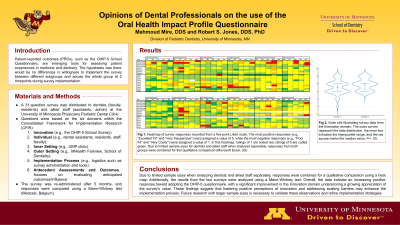Practice Management
169 - Implementation Science Approach to Oral Health Quality of Life Survey


Mahmoud Mire, DDS
Resident
University of Minnesota
University of Minnesota
Minneapolis, Minnesota, United States
Robert S. Jones, DDS, PhD
Research Mentor
University of Minnesota
University of Minnesota
Minneapolis, Minnesota, United States
Jeff Karp, D.M.D., M.S.
Residency Program Director
University of Minnesota
School of Dentistry , University of Minnesota
Minneapolis, Minnesota, United States
Presenting Author(s)
Research Mentor(s)
Program Director(s)
Title: Implementation Science Approach to Oral Health Quality of Life Survey
Mire M, Jones RS (University of Minnesota, Minneapolis, MN)
Purpose: This study investigates the factors influencing the adoption and implementation of the Oral Health Impact Profile-5 (OHIP-5) questionnaire in a pediatric dental clinic. Specifically, it compares the willingness of allied dental staff to implement the questionnaire with other professional groups, such as residents and faculty. The null hypothesis suggests no significant differences in willingness between these groups.
Methods: A 31-question survey was distributed to dental professionals and allied staff at the University of Minnesota Physicians Pediatric Dental Clinic. The survey was derived from the Consolidated Framework for Implementation Research (CFIR), addressing domains like ease of use, alignment with patient needs, and organizational culture. Descriptive and statistical analyses were conducted to compare responses from different professional groups..
Results: Due to small sample sizes, dental providers and allied staff were combined for analysis. The initial survey received 18 responses (8 dentists, 10 allied staff). After 5 months, a second survey yielded 16 responses (9 dentists, 7 allied staff). A Mann-Whitney U test showed a significant increase in the Innovation domain (p = 0.05). While no significant differences were found in other domains, a general increase in mean scores across all domains was observed.
Conclusion: The results suggest that, although willingness to adopt the OHIP-5 differs by domain, the overall increase in positive responses indicates progress in implementation. The significant improvement in the Innovation domain points to a growing perception of the tool's value. Further research with larger sample sizes is needed to confirm these findings and refine implementation strategies.

.jpg)